Types of gas cylinders: full classification + analysis of labeling
Gas cylinders are widely demanded both in industry, and in medicine, aviation, space industries, in everyday life, as an autonomous energy source. They can be used both for heating, and for lighting, cooking.
To exclude all sorts of troubles associated with the operation, you need to choose the right type of equipment. Let's try to understand together the types of gas cylinders, the features of their design and connection.
The content of the article:
Gas cylinder device
Both for storage and transportation of compressed and liquefied gas, gas cylinders have been created - special vessels in which these substances are under high pressure. The first type of gas under any pressure is in a gaseous state, and the second, with the growth of this parameter, goes into the liquid phase.
In a compressed and liquefied state, nitrogen, fluorine, oxygen, methane, hydrogen, as well as chlorine, carbon dioxide, and ammonia are transported and stored.
The tank itself is an all-welded construction with walls at least 2 mm thick with geometry in the form of a cylinder. It is made of steel or polymer.
Its components:
- shell;
- neck;
- bottom.
The neck of the container has a tapered thread under shutoff valvehermetically sealed outlet. In the case when, for some reason, the expansion of the gas occurs, under the influence of pressure the valve will break and the pressure inside the vessel will return to normal.
The gas inside such a vessel is at a maximum pressure of 15 MPa. There is a welded single seam in the body of the container or the shell.
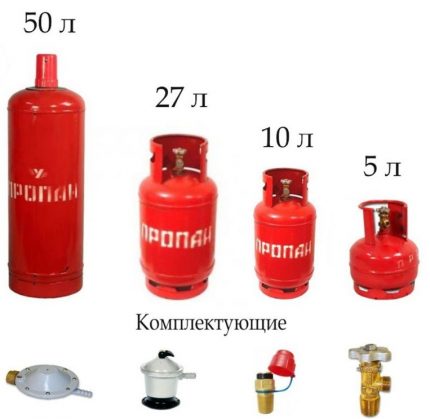
In order for the gas inside the vessel to exert the same pressure on its walls, each cylinder has a convex bottom - upper and lower.For greater stability, the cylinder is equipped with an annular support - a shoe. In addition, the gas tank has in its kit a metal or plastic cap that protects the valve during operation and transportation.
The cap is screwed onto the neck ring. Sometimes the cylinder is supplied gearboxdesigned to balance pressure. The valve is a node, which includes a steel body in the form of a tee, a flywheel, a locking element.
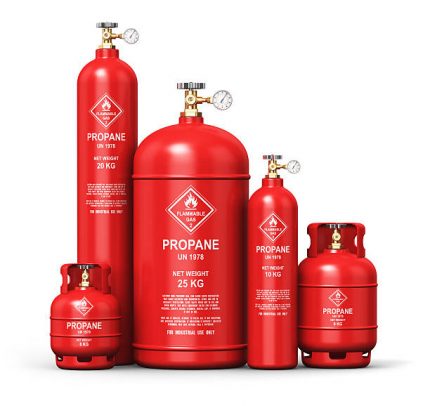
An assembly consisting of a check valve and a stem is called a shut-off element. Each of the parts of the assembly performs its function.
The valve is needed to regulate the gas supply through the housing, and the stem - for the interaction of the flywheel with the valve through torque. By turning the handwheel, you can close or open the gas flow.
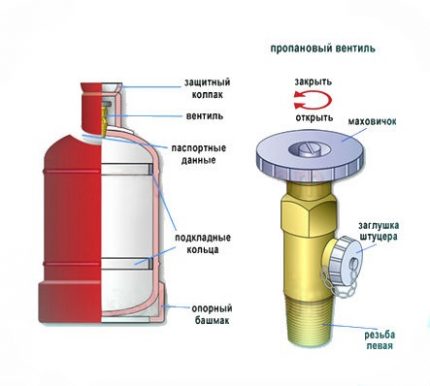
Types of gas cylinders
Gas vessels are classified according to many criteria: body material, volume, purpose, filler name, method of connection. For the manufacture of the body, both metal and composite materials are used. Both have their advantages and disadvantages. You should familiarize yourself with them for the right choice.
Classification by case material
For the manufacture of a metal cylinder body, alloy or mild steel is used. The capacity of metal vessels is from 5 to 50 liters. Cylinders with a capacity of less than 50 liters are allowed to be installed inside the house, and 50 liters - only outside.
The latter need protection from direct sunlight. To do this, they are placed in a lockable metal cabinet with markings on it, corresponding to the type of gas. An empty metal can weighs from 4 to 22 kg.
The vessel is filled with gas at a maximum of 85%. Depending on the volume, 2 to 22 kg of gas is charged into the cylinder. This gas equipment is explosive and fire hazard. Temperature over 50⁰ is contraindicated to him. During sharp jumps in temperature and in case of fire, a powerful explosion occurs. You can’t turn such a balloon sharply, as this causes an increase in pressure.
Composite gas bottle is a newer option. Its main advantage is complete explosion safety, even if a gas leak occurs. In such containers liquefied gases are transported and stored. When exposed to an open flame, the gas escapes through the housing gradually and simply burns out.
They are light in weight - 70% lighter than metal counterparts, and feature a stylish design. Thanks to the transparent case, you can always control the gas level. In contrast to metal, the composite material is not susceptible to corrosion, therefore, is more durable.
The polymer has excellent dielectric properties, 100% excluding sparking. The temperature range is between -40 - 50⁰. Cylinders are recommended to operate up to 30 years. Every 10 years they must undergo recertification. The mass of the cylinder is 8 kg maximum.
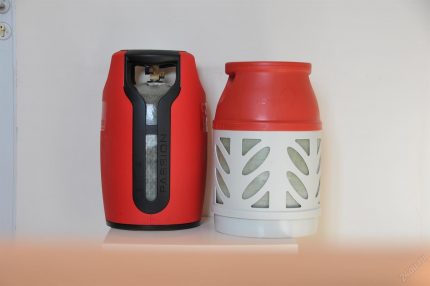
Composite gas cylinders come in two forms: those made by blowing technology and by winding fiberglass onto a mandrel. In the first case, the flask is made of polyethylene terephthalate. Further, manufacturers cover the vessel made of fiberglass yarns with epoxy. The capacity is put in a polymer case.
In the manufacture of cylinders of the second type, a special mandrel is used. Fiberglass is wound on it, then the preform is impregnated with resins. Initially, two halves of the vessel are obtained. After curing, they are glued and placed in a dense polyethylene casing.
Due to the presence of overpressure valve and fusible rate, composite cylinders have increased security. In case of fire, the fuse-link is triggered. When melted, it gradually releases gas, with full control of the process. After operation of the insert, the cylinder is not subject to further operation.
Separation by installation location and purpose
All existing gas cylinders, depending on where they are installed and what they are intended for, are divided into the following types:
- Household. They are used for heating, stoves, boilers.
- Automotive. They are used on cars in which the engine runs on gaseous fuel.
- Tourist. Suitable for mobile devices such as blowtorches, burners, barbecue, heaters.
- Industrial. This category includes containers in which gases are stored. Such cylinders are used in metallurgy, chemical industry, and pharmaceutical enterprises.
- Medical. They are filled with breathing mixtures and carried in ambulances, used in hospital wards for intensive care and where oxygen cocktails are prepared. Apply such cylinders and rescuers, firefighters.
There are universal cylinders that are used in many industries. For mobile gas appliances, they produce single-use cartridges containing 100 - 450 g of gas. Visually, they resemble aerosol sprays.
Features of the classification by filler
Based on the composition of the mixture, the cylinders are called propane, butane, hydrogen, nitrogen, acetylene, carbon dioxide, argon, oxygen, helium, etc. Each of the compositions has its own temperature regime.
For standard conditions, the difference between them is small. When the balloon is needed for use in high mountain regions or at very low temperatures, this parameter plays a decisive role.
Butane isomer - a mixture of isobutane with propane, well suited for low temperatures. It is safe for the ozone layer. Both propane and butane are very dangerous for humans. If you inhale them, serious consequences for the body are inevitable. Direct contact with liquid butane leads to body cooling to -20⁰.
Lighters are charged with butane; in air conditioners and refrigeration units it is sometimes used as a refrigerant. Propane is required in the manufacture of solvents. To work with metal associated with its welding and cutting, acetylene is required. It is also used in the production of explosives, acetic acid, rubber, all kinds of plastics, for rocket engines.
Nitrogen uses the electronic industry, chemical, oil and gas, pharmaceuticals, metallurgy. Hydrogen is needed in the food and chemical industries. It is also used as fuel for missiles during welding.
Bicycle wheels, fire extinguishers are pumped with carbon monoxide or carbon dioxide. In the food industry, carbonated drinks are produced with its use. In the form of dry ice, carbon monoxide is used as a refrigerant.
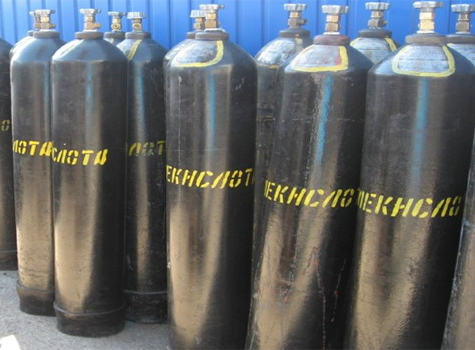
In the metallurgical, metalworking industry, in processes where the interaction of the molten stream with oxygen is unacceptable, argon is used. It is also used in medicine for anesthesia, with its help they purify the air. Helium cylinders are necessary not only for filling balloons, but also for cutting, welding, and melting metal.
This gas is part of the breathing mixtures used in diving, it can be a refrigerant in scientific experiments. Ammonia is a strong solvent. Since it is very poisonous, cylinders with it must be transported and stored very carefully. The same goes for chlorine tanks.
Oxygen tanks can be found near welding machines, where they produce explosives, acids, and prepare oxygen cocktails. Compressed air transported in cylinders is most often used in the operation of pneumatic devices.
Methane liquefied natural gas is used as a sleeping pill in medicine, for the production of fertilizers, in the form of fuel. For humans, this gas is safe.
Types of cylinders by connection method
Different models of gas cylinders are connected to the devices through four connection standards. The most popular is threaded A standard that meets all safety requirements. Products have a 7/16 ″ thread. A hose or torch is attached to such cylinders by screwing.
The next balloon standard is collet. This type of connection is also called push or clamp. A cylinder with this type of connection is considered the cheapest. Here, the role of the clamp when connected is played by a cylindrical part. The collet can be connected to threaded equipment, but an adapter is required for this.
The punctured type of cylinders in the world is the most common. These disposable cylinders have the disadvantage that it is not possible to disconnect the container until all gas has been used. Recent models of pierced cylinders with the SGS system are devoid of this drawback.
Here it is possible to block the gas leak when disconnected from the burner and turn off the incompletely empty tank. They are used for blowtorches, lighting lamps, portable stoves.

Valve connection is the type that is used mainly in Europe. The connection is simple and reliable with a high degree of leakage protection.
Explanation of cylinder marking
By reading the markings correctly, you can get complete information about the gas cylinder. If this is a propane cylinder, then his passport is in the valve area, on a metal mug.
In the passport of a propane cylinder it is indicated: operating pressure in MPa, test pressure in the same units, actual capacity in l, serial number, production date in the form of "MM.GG.AA", where the first characters indicate the month, the second - the year , third - the year of the upcoming certification.
The following is the weight of the empty cylinder in kg, the mass of the filled cylinder. The last line is the lettering “R-AA”. “R” is the mark of the recertification site or plant. The combination of characters "AA" discloses information about the year until which this certification will be valid.
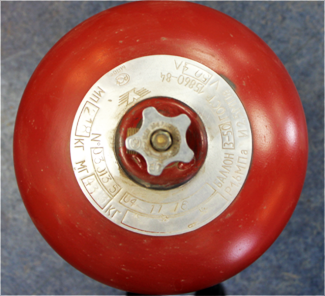
The marking of the oxygen cylinder has its own order and consists of four lines. The first one contains information about the manufacturer, as well as the capacity number. The second is the release date and the recommended verification date. In the third - hydraulic and working pressure. In the fourth - the volume of gas and the mass of the container without valve and cap.
When buying a cylinder, you should pay attention to how the information is applied to it. On the case it is not applied with paint, but knocked out, and then coated with a special colorless varnish in order to protect it from corrosion. Often the last line contains the brand of the manufacturer.
Features of painting gas cylinders
Compressed gas cylinders in Russia and abroad are colored differently. At the same time, each type of gas corresponds not only to a certain color of the case, but also to the color of the strip and the inscription.
The table shows the identification colors of the cylinders with some types of gases, as well as the color of the inscriptions and stripes.
| Gas | Cylinder color | Inscription | Strip |
| Ammonia | Yellow | The black | Brown |
| Nitrogen | The black | Yellow | Brown |
| Argon technical and clean | Black, gray respectively | Blue; green | Blue; green |
| Acetylene | White | Red | Green |
| Butylene | Red | Yellow | The black |
| Butane | Red | White | The black |
| Hydrogen | Dark green | Red | The black |
| Compressed air | The black | White | The black |
| Helium | Brown | White | The black |
| Oxygen | Blue | The black | The black |
| Hydrogen sulfide | White | Red | Red |
| Carbon dioxide | The black | Yellow | Yellow |
Nitrous oxide is pumped into a gray cylinder with a black inscription and the same strip. The protective color of the phosgene cylinder has a yellow inscription and a yellow stripe, and the same color cylinder, but with a black inscription and a green stripe, contains chlorine. The aluminum color of the container, the black inscription on it and two stripes of yellow indicate that it is filled with Freon-22.
For sulfur dioxide is a black cylinder with a white stripe and a yellow inscription. Ethylene is enclosed in a purple balloon with a red inscription and a strip of green. For other combustible gases, red vessels with a white inscription and a green stripe are intended. Non-combustible gases are indicated by a yellow inscription on a black background of the case and a green stripe.
Types of cylinder malfunctions and their elimination
All faults existing in gas cylinders are divided into two types: to be eliminated and not to be eliminated.
The first type includes:
- incorrect operation of the cylinder valve and manometer;
- damage to the shoe or its displacement;
- damage to the threaded connection;
- leak of gas;
- in many places the peeling coloring of the body.
The second type of malfunction is a significantly damaged surface of the case in the form of dents, cracks, swelling, lack of marking. In this case, the cylinder is rejected. The decision on the possibility or impossibility of repair is made by a specialist with the appropriate qualifications.
When repairing gas cylinders, defective elements are often easily replaced. Sometimes internal flushing of the container and checking for corrosion from the inside is required. Periodic inspection includes all these works, and upon its completion issue a certificate.
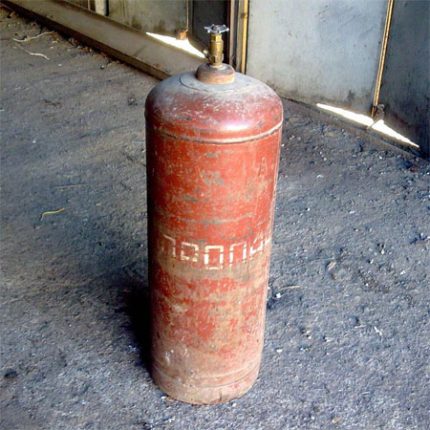
At home, this should not be done. All you can do yourself is paint the body of the container. This must be done very carefully so as not to paint over the labels and not damage the markings. All other malfunctions can be eliminated only by a specialized workshop or manufacturer.
Popular gas cylinder manufacturers
Among many manufacturers of cylinders, the Russian brand should be distinguished "Sledopyt". Two types of gas cylinders with threaded and collet connections are offered here - for an all-weather mixture and a winter one. American firm Jetboil supplies cartridges filled with propane and isobutane, which can be used in winter.
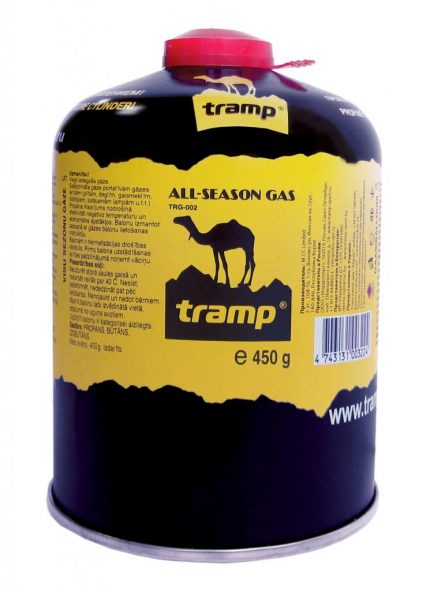
French company Campingaz produces all kinds of appliances equipped with gas cylinders. The type of connection they have is collet, valve or puncture. Primus - produces several types of gas cartridges. The connection in all is threaded.
Composite vessels of good quality are supplied by the Czech brand Research. The set includes special valves that protect the tank from overfilling. All of these cylinders are explosion proof.
Conclusions and useful video on the topic
Video about the correct use and examination of gas cylinders. Tips from a specialist:
About liquefied gas composite cylinders:
A gas bottle is a useful thing in the household. To its operation did not lead to undesirable consequences, it is necessary to properly study the issue. And most importantly, adhere to basic safety rules.
Do you have any questions after reading the material? You can set them in the block below.There you can share the experience of using gas cylinders, tell what equipment you use.

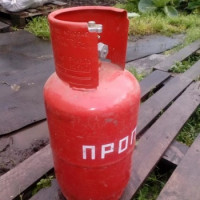 Refueling household gas cylinders: rules for filling, servicing and storing cylinders
Refueling household gas cylinders: rules for filling, servicing and storing cylinders 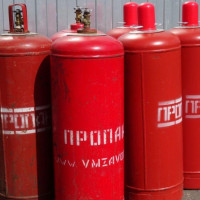 Characteristics of typical 50 liter gas cylinders: design, dimensions and weight of the cylinder
Characteristics of typical 50 liter gas cylinders: design, dimensions and weight of the cylinder 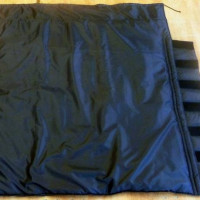 How does a thermal blanket work for gas cylinders: features of the device and use + selection tips
How does a thermal blanket work for gas cylinders: features of the device and use + selection tips 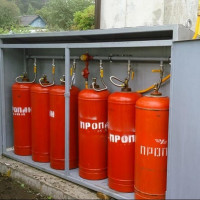 Gas cylinder cabinet: cylinder storage requirements + cabinet selection and installation tips
Gas cylinder cabinet: cylinder storage requirements + cabinet selection and installation tips 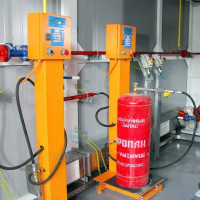 Filling rules for household gas cylinders at gas stations: safety standards and requirements
Filling rules for household gas cylinders at gas stations: safety standards and requirements 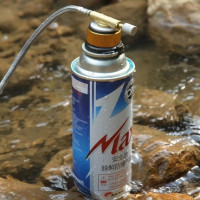 Do-it-yourself gas cans for burners: instructions for different types of cylinders
Do-it-yourself gas cans for burners: instructions for different types of cylinders  How much does it cost to connect gas to a private house: the price of organizing gas supply
How much does it cost to connect gas to a private house: the price of organizing gas supply  The best washing machines with dryer: model rating and customer tips
The best washing machines with dryer: model rating and customer tips  What is the color temperature of light and the nuances of choosing the temperature of the lamps to suit your needs
What is the color temperature of light and the nuances of choosing the temperature of the lamps to suit your needs  Replacement of a geyser in an apartment: replacement paperwork + basic norms and requirements
Replacement of a geyser in an apartment: replacement paperwork + basic norms and requirements
I remember how, even at the university, a whole lecture on the subject of labor protection was devoted to this topic. I liked your section about malfunctions in cylinders and their elimination, it is a pity that a little. And let me add on my own: such an important aspect as safety measures for the operation of gas cylinders is completely absent. Well, adding a little to refueling a bottle would not hurt.
Hello, thank you. We will inform the administrator of your wishes and hope that soon a separate article on this topic will appear on the site.
Before we connected to the main gas pipeline, we used cylinders in the country. Usually there was enough gas for a long time. But the cylinders have such a feature - gas always runs out of time, when there is no transport or other opportunity to go and buy. Cylinders bought metal for 50 liters. Usually for the season of active use of the cottage from April to October spent two cylinders.
Nothing about w21.8 and G5 / 8 connections
What color of the cylinder can I refuel with SF6?
Hello. This is a black steel cylinder with a working pressure of 150 MPa, with a yellow enamel inscription “ELEGAS”.
Hello! Tell me, please, is it possible to fill oxygen or carbon dioxide into a cylinder from under argon?